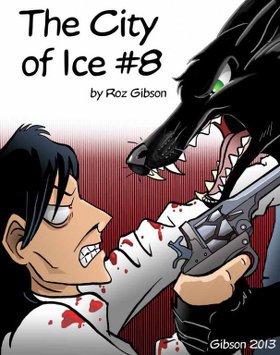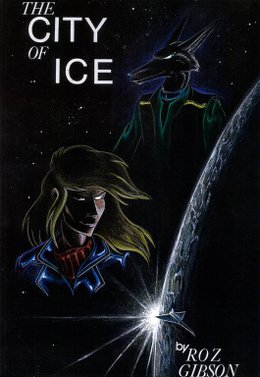Review: 'The City of Ice', chapters 1-8, by Roz Gibson
Fourteen years ago, comic artist and animator Roz Gibson published the first chapter of The City of Ice. At Anthrocon 2013 she brought the series to a close with The City of Ice #8.

Roz Gibson’s background is in classical sequential and animation art, and her major influences are classic science fiction and the political realism found in works like Frank Herbert’s Dune. Graphic novel and science fiction aficionados should find her work especially appealing, as will anyone intrigued by a hard-edged, politically and economically credible world inhabited by both humans and sapient animal-based non-humans.
The events in The City of Ice take place immediately after those of Gibson’s early novel Jet, 2350, and fifty years prior to Jack Salem’s career. Fans of the Jack Salem series will learn how Jack’s world came into being, and even meet a familiar character.
Gibson’s alternate universe is founded on the invention of a matter-energy transformation computer, commonly called The Dream Machine. This device gives its five creators godlike powers to create or change matter, or even life, at will. It is permanently bound to the will of its makers, whose bodies it automatically repairs or even recreates when damaged by aging or injury.
Effectively living gods, the five Creators have the power to remake the world into a utopia, or so it seems when they effortlessly eliminate pollution, deadly diseases, and food shortages. Over the years, the Creators' link to the Dream Machine begins to affect their sanity and magnify their hubris. Their interventions become more controversial, and when global overcrowding reaches crisis levels, Creator Jeffery Scott solves the problem on his own, by annihilating most of the world’s population. Partly out of remorse, one of the other Creators, Victor Goldstein, starts to create sapient non-human species.
As The City of Ice begins, humans are extinct on Earth, and the old nations have broken up into small states run by non-human dictators. The only humans remaining are the two Creators Goldstein and Sanuki, now centuries old, and Jet Vanelski, who was sent to Earth as a child refugee from the terraformed Mars, now called Planet Maxwell. With help from the two Creators, Jet and the jackal-like dictator of New York, Governor Reezon, are en-route to Maxwell to find out what happened to the colony, which has been out of contact for over a century. They have good reason to be apprehensive about what they might find. The Creators on Planet Maxwell include the psychopathic Jeffery Scott and his passive but nearly equally amoral colleague George Maxwell.
Jet and Reezon deeply distrust each other, and in the brutal, totalitarian City of Ice, simply surviving food shortages and the ruthless secret police is a challenge. Reezon’s own ambitions are far more dangerous. Allying himself with Jeffery Scott's son, Markus Scott Hall, he drags the unwilling Jet into a deadly political chess game against Scott and Maxwell.
Despite its long production cycle, The City of Ice is remarkably consistent in style and direction from the first issue to the last. Later chapters benefit from more ambitious backgrounds, the stronger use of dramatic contrast, and refined shading with the skillful use of gradients. I also observed a notable improvement in Gibson’s portrayal of facial expressions, which otherwise tend towards a distinctive sneer.
Gibson does not avoid perspective or skimp on background. It is never difficult to tell where the characters are in relation to their environment, or what is happening during dense action scenes. Changes in perspective are easy to follow. The consistent detail in the backgrounds lets the City of Ice come to life as a living, breathing city, filled with millions of humans and nonhumans whose fate rests intimately on the events of the story.
One needs to give the work a second or third reading to appreciate how good the perspective and background work is, since at a first reading it is transparent. One simply takes for granted having a perfect view of events as they unfold.
While the inking is consistently excellent, the first five chapters suffer from monotonous screentone shading, which combined with the high-resolution printing often creates dizzying moiré patterns. By chapter six, Gibson has added a confident mastery of digital greyscale shading and gradients to her hand-inked style, making even the most gruesome scenes a delight to the eye.
Unusually for artists of her caliber, Roz Gibson can write and plot as well as she inks. There are no dull moments in The City of Ice, nor frenetic action to no purpose. The story is tightly plotted, well-paced, and the numerous important characters have distinct personalities and are easy to keep track of despite the complexity of the plot. City Council Chairmen Jeffery Scott and George Maxwell are memorable and frightening antagonists. Scott is an insane, sadistic, psychopathic genius, whose associates live in terror of his unpredictable rages. Maxwell is emotionally distant and clear-headed in a crisis, but only occasionally acts to restrain Scott's destructive urges. Their mundane titles and unchanging 1980’s era business suits and hairstyles add a unique tone of bureaucratic stuffiness to their joint reign of terror.
 The story is not without flaws. Jet initially appears to be an important character, but is sidelined early on in favor of Reezon as the driving force for the plot. It’s not clear what Jet really wants, and while he plays a useful supporting role as a foil and gadfly for Reezon and Markus, he is too unambitious to be much of a challenge to anyone. His role at the end of the story is genuinely confusing.
The story is not without flaws. Jet initially appears to be an important character, but is sidelined early on in favor of Reezon as the driving force for the plot. It’s not clear what Jet really wants, and while he plays a useful supporting role as a foil and gadfly for Reezon and Markus, he is too unambitious to be much of a challenge to anyone. His role at the end of the story is genuinely confusing.
In chapters two and three, Gibson sets up a potential conflict between Reezon’s contempt for religion and the politically significant and apparently vaguely fundamentalist religious minority in the City. Gibson never develops this conflict, and religion simply disappears from the story. The fundamentalist city council member is set up as a potentially difficult challenge for Reezon and his allies, but he’s simply killed off without ceremony or consequence.
While chapter eight brings Reezon and Markus Hall's story to a natural stopping point, some important characters’ stories and several loose ends are never resolved, even provisionally. The climax of The City of Ice is thrilling, but the work needed a longer denouement to satisfy the reader’s desire for closure.
The City of Ice features graphic violence and cruelty, and some sex, although it is always contextual and never gratuitous. The series is only appropriate for mature readers, to whom I give it my highest recommendation.
The City of Ice is currently available at Second-Ed Comics.
Individual chapters range in price from $7.50 to $14.95.
Individual pages of The City of Ice #1 can be viewed on Roz Gibson's Fur Affinity account.
Full disclosure: I performed minor proofreading and printed the interior pages for 'The City of Ice #8', and had access to the complete work before publication. At no point did Roz Gibson or I discuss the possibility of my writing a review of her work.
Comments
Fans of Gibson's "The City of Ice" should not miss her new short story, "The Monkeytown Raid", in my just-published anthology "What Happens Next" (FurPlanet, July 2013). Both her "The City of Ice #8" and my "What Happens Next" were premiered at Anthrocon 2013.
Fred Patten
Post new comment